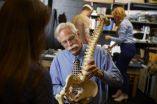(Press-News.org) Newly published findings from the University of Waterloo are giving women with bad backs renewed hope for better sex lives. The findings—part of the first-ever study to document how the spine moves during sex—outline which sex positions are best for women suffering from different types of low-back pain. The new recommendations follow on the heels of comparable guidelines for men released last month.
Published in European Spine Journal, the female findings debunk the popular belief that spooning—where couples lie on their sides curled in the same direction—is the best sex position for all women with low-back pain.
"Traditionally, spooning was recommended by physicians to all individuals with back pain because it was thought to reduce nerve tension and load on the tissues," said Natalie Sidorkewicz, the PhD candidate at Waterloo who led the study. "But when we examined spine motion and muscle activity, we found that spooning can actually be one of the worst positions for certain types of back pain."
The pioneering research combined infrared and electromagnetic motion capture systems, like those used by filmmakers for full computer graphic character animation, to track how 10 couples' spines moved when attempting five common sex positions. The findings were used to create an atlas, or illustrated set of guidelines that recommends different sex positions based on what movements trigger a patient's pain.
The atlas suggests that women who are extension-intolerant, meaning those whose back pain is made worse by arching their backs or lying on their stomachs, for example, replace spooning with the missionary position. Adding a low-back support, such as a pillow, can also help keep the spine in a more neutral position. For women who are flexion-intolerant, typically those whose back pain is made worse by touching their toes or sitting for long periods of time, the atlas recommends spooning or doggy-style sex where the woman is supporting her upper body with her hands, not her elbows.
"What we know now is that sex positions that are suitable for one type of back pain are not appropriate for another kind of pain," said Sidorkewicz. "These guidelines have the potential to improve quality of life—and love life—for many couples."
According to Statistics Canada, four of every five people will experience at least one episode of disabling low-back pain in their lifetime. Up to 84 per cent of men with low-back pain and 73 per cent of women report a significant decrease in the frequency of intercourse when suffering back pain.
"Primary care physicians report it is common for couples to seek their advice regarding how to manage their back pain during and after sex. Many couples will remain celibate because the pain resulting from one night of lovemaking lasts months," said Professor Stuart McGill, of the Faculty of Applied Health Sciences at Waterloo. "Now doctors have solid science to guide their recommendations."
The next phase of the study will involve recruiting patients with different categories of back and hip pain, as well as additional sex positions, to further develop the recommendations.
INFORMATION:
European Spine Journal article: http://link.springer.com/article/10.1007%2Fs00586-014-3626-y
Guidelines for men previously published in Spine: http://journals.lww.com/spinejournal/pages/articleviewer.aspx?year=2014&issue=09150&article=00005&type=abstract
Down syndrome is the most common chromosomal abnormality in humans, involving a third copy of all or part of chromosome 21. In addition to intellectual disability, individuals with Down syndrome have a high risk of congenital heart defects. However, not all people with Down syndrome have them – about half have structurally normal hearts.
Geneticists have been learning about the causes of congenital heart defects by studying people with Down syndrome. The high risk for congenital heart defects in this group provides a tool to identify changes in genes, both on and ...
In early drug discovery, you need a starting point, says Northeastern University associate professor of chemistry and chemical biology Michael Pollastri.
In a new research paper published Thursday in the journal PLOS Neglected Tropical Diseases, Pollastri and his colleagues present hundreds of such starting points for potentially treating African sleeping sickness, a deadly disease that claims thousands of lives annually.
Pollastri, who runs Northeastern's Laboratory for Neglected Disease Drug Discovery, ...
WASHINGTON – October 24, 2014 – Policy options for climate change risk management are straightforward and have well understood strengths and weaknesses, according to a new study by the American Meteorological Society (AMS) Policy Program.
"Large gaps remain in society's consideration of climate policy," said Paul Higgins, the author of the study. "This study can help in the development of a comprehensive strategy for climate change risk management because it explores a much larger set of policy options."
The study identifies four categories of climate ...
Washington, D.C., October 24, 2014 -- Only 6 percent of U.S. hospitals are well-prepared to receive a patient with the Ebola virus, according to a survey of infection prevention experts at U.S. hospitals conducted October 10-15 by the Association for Professionals in Infection Control and Epidemiology (APIC).
The survey asked APIC's infection preventionist members, "How prepared is your facility to receive a patient with the Ebola virus?" Of the 1,039 U.S.-based respondents working in acute care hospitals, about 6 percent reported their facility was well-prepared, while ...
LAWRENCE – 'Call your mother' may be the familiar refrain, but research from the University of Kansas shows that being able to text, email and Facebook dad may be just as important for young adults.
Jennifer Schon, a doctoral student in communication studies, found that adult children's relationship satisfaction with their parents is modestly influenced by the number of communication tools, such as cell phones, email, social networking sites, they use to communicate.
Schon had 367 adults between the ages of 18 and 29 fill out a survey on what methods of communications ...
VIDEO:
The Jones lab details a new target to fighting HIV.
Click here for more information.
LA JOLLA—Like a slumbering dragon, HIV can lay dormant in a person's cells for years, evading medical treatments only to wake up and strike at a later time, quickly replicating itself and destroying the immune system.
Scientists at the Salk Institute have uncovered a new protein that participates in active HIV replication, as detailed in the latest issue of Genes & Development. ...
Spectacular eruptions at Bárðarbunga volcano in central Iceland have been spewing lava continuously since Aug. 31. Massive amounts of erupting lava are connected to the destruction of supercontinents and dramatic changes in climate and ecosystems.
New research from UC Davis and Aarhus University in Denmark shows that high mantle temperatures miles beneath the Earth's surface are essential for generating such large amounts of magma. In fact, the scientists found that the Bárðarbunga volcano lies directly above the hottest portion of the North Atlantic ...
Harvard Stem Cell Institute scientists at Massachusetts General Hospital have devised a new way to use stem cells in the fight against brain cancer. A team led by neuroscientist Khalid Shah, MS, PhD, who recently demonstrated the value of stem cells loaded with cancer-killing herpes viruses, now has a way to genetically engineer stem cells so that they can produce and secrete tumor-killing toxins.
In the AlphaMed Press journal STEM CELLS, Shah's team shows how the toxin-secreting stem cells can be used to eradicate cancer cells remaining in mouse brains after their main ...
A new study has found that implementing stricter fisheries management overcame the expected detrimental effects of climate change disturbances in coral reef fisheries badly impacted by the 1997/98 El Niño, according to the Wildlife Conservation Society.
The 17-year study led by WCS fisheries scientists found that rapid implementation of fisheries restrictions countered adverse climate effects and actually increased fisheries catches, counter to predictions and findings in other studies without stricter management. This is good news for the millions of people who ...
Physics researchers at Virginia Commonwealth University have discovered that most of the electrolytes used in lithium-ion batteries — commonly found in consumer electronic devices — are superhalogens, and that the vast majority of these electrolytes contain toxic halogens.
At the same time, the researchers also found that the electrolytes in lithium-ion batteries (also known as Li-ion batteries) could be replaced with halogen-free electrolytes that are both nontoxic and environmentally friendly.
"The significance [of our findings] is that one can have a ...





